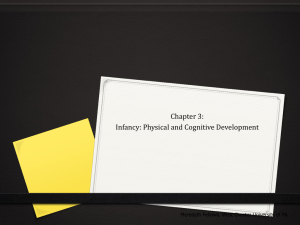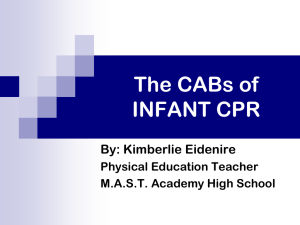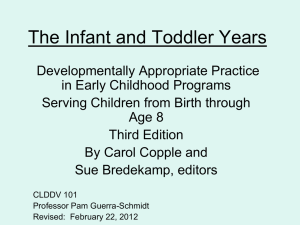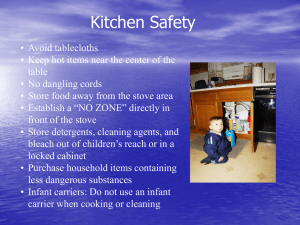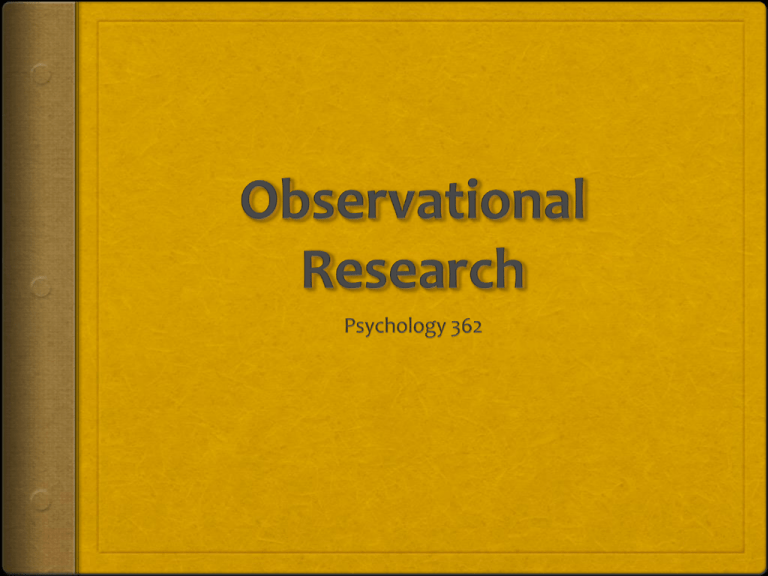
Sampling Considerations
Complete records are often cumbersome and cannot be
obtained easily. A representative sample of behavior can
often be generalized.
Situation Sampling
Time Sampling
Event Sampling
Types of Observation
Naturalistic Observation
Deliberate and planned recording of observations in a
natural environment, in which the behavior of the Ss is
essentially unaffected by the observation process
Unobtrusive recording of behavior in a natural
environment
Naturalistic Observation
The case for Naturalistic Observation
External Validity
Ethical limits on experiments
Weak facsimile environments
Some things can’t be experimented upon at all
Naturalistic Observations using
Participant Observation
Participant Observation- The observer attempts to
assume a natural role within the social situation that
she is investigating to observe from the “inside out”
Jane Goodall
John Howard Griffin “Black Like Me”
Structured Observations
Records behaviors that are difficult to observe using
naturalistic observation
Observations that involve some kind of intervention
Types of Structured
Observations
Field Experiment Observations
Researchers manipulate one or more independent
variables in a natural setting to determine effect
on behavior
Laboratory Observations
Researchers manipulate one or more independent
variables in an artificial setting or facsimile
environment to determine effect on behavior
Example of Structured
Observation
Simons and Levin(1998)- Change blindness study
using confederates that were switched out by use of
a distraction. Only half of subjects noticed switch
Whether Natural or Structured all
Research Observations should be
Systematic
Careful observation of one or more behaviors in a
particular setting
3 things make it systematic:
1) interested in only specific behaviors
2) quantifiable
3) hypothesis-driven
Systematic Observational Study in
Rhesus Monkeys
Collecting ethnographic data
Using a systematic chart to determine behavioral
criteria
Ethogram
States (Code)
Definition
Ventral-Ventral Contact (VC)
another subject.
Ventral surface of the focal infant contacts ventral surface of
Ventral-Ventral Contact Sleep (LV) Ventral surface of the focal infant contacts ventral surface of
another subject while asleep
Ventral-Ventral Contact Groom (VG)
Ventral surface of the focal infant contacts ventral
surface of another subject while also receiving groom
Sleep Contact (SL)
animals.
Sleep Proximity (LP) Focal animal is asleep while in proximity with other animals.
Sleep Solo (SO)
animals)
Extended Groom (EG) One animal examines, picks, or licks at the other animal’s fur or body part for
longer than 3 seconds (while not in breast or ventral contact)
Extended Contact (EC)
Any physical contact between focal infant and other subject not
described as ventral or groom contact.
Proximity (PR)
Proximity is scored when the focal animal is within arm’s reach of another
subject, but not in physical contact (proximity with an adult = length of adult arm, proximity with
another infant = length of infant arm).
Extended Play (EP)
Focal animal is asleep while in contact (most likely huddle contact) with other
Focal animal is asleep while non-social (not in proximity or contact with other
Any instances of play lasting for longer than 3 seconds.
Extended Mount (EM)
than 3 seconds.
Mounting (complete or incomplete) that lasts for more
Extended Negative (EN)
seconds.
Any instances of aggression that last longer than 3
Extended Stereotypy (ES) The focal infant is engaged in stereotypic behavior for
longer than 6 seconds
Extended Toy Play (ET)
The focal infant is playing with a toy for longer than 6
seconds. (NOTE: if the focal infant is in a social state (i.e., proximity) score the social
state over the extended toy play state).
Extended Oral Explore (EO)
The focal infant is oral exploring the cage for
longer than 6 seconds. (NOTE: if the focal infant is in a social state (i.e., proximity)
while oral exploring, score the social state over the extended oral explore state).
Social Activity (SA)
The infant is not in proximity or contact with one specific
subject, but is actively moving among the group within arm’s reach or contact of the
other subjects. Change state to Nonsocial Activity if 3 seconds pass without a social
interaction with another subject.
Nonsocial Activity (NA)
The infant remains out of proximity, contact, and social
activity for more than 3 seconds, but has head up, looking around or actively walking
around the cage.
Nonsocial Inactivity (NI) The infant remains out of proximity, contact and social
activity for more than 3 seconds and is showing passive behavior (head down, not
exploring cage/objects, not looking at other subjects).
Facial Expression Events
Fear Grimace (FG)
Exaggerated grin with teeth showing is given by
subordinate animals to dominate animals.
Lipsmack (LI)
Rapid lip movements with pursed lips, usually accompanied by
smacking sounds.
Threat (TH)
Components of threat include open mouth stare, lunge, head
bobbing, vocalization bark, and ear flaps.
Play Threat (PT) Scored when open mouth threats, ear flaps, lunges or head bobs
occur when animals are engaged in Rough and Tumble play
Exploration Events
Manual (ME)
Specifically oriented manual exploration of the cage or other
objects (do not score manipulation of food items or other animals).
Oral (OE)
Specifically oriented oral exploration of the cage or other objects
(do not score manipulation of food items or other animals).
Anogenital exploration (AE)
Oral, olfactory or manual exploration of
anogenital area. NOTE: if an animal sniffs in order to anogenital explore, score both
the anogenital explore event and the sniff event
Sniff (SN)
Animal noticeably sniffs or muzzles another animal. NOTE: if an
animals contacts the other animal upon a sniff, score both the sniff and the contact
event
Movement Events
Approach (AP) Scored when an infant moves within arm’s reach of another subject.
Do not score if the infant walks past the second infant without directly approaching
the second infant (approach must be intentional)
Avoid (AV)
Animal leaves the area due to the arrival of another animal. Animal
does not have to be directly displaced in order to score. (DO NOT SCORE WHEN
ANIMALS ENGAGED IN PLAY)
Flee (FL)
Scored when the infant moves away (out of arm’s reach) from
another subject based on that animal’s behavior. Often deliberate, intentional, and
rapid, occurring when an animal approaches, looks at, or threatens another (often in
a negative context) (DO NOT SCORE WHEN ANIMALS ENGAGED IN PLAY)
Chase (CH)
seconds.
One infant chases, or is chased by another subject for more than 3
Follow (FO)
Scored when an animal appears to be intentionally following
another animal for more than 3 seconds.
Displacement (DI)
Scored when another subject approaches and “takes the
place” of the other subject.
Freeze (FZ)
Scored when an animal does not move (crouching or sitting) for
more than 3 seconds.
Withdraw (WI) Scored when an infant moves out of arm’s reach of another subject
after participating in a state of proximity or contact.
Physical Contact Events
Groom (GR)
One animal examines, picks, or licks at the other animal’s fur or body part. (NOTE: Periods of
groom lasting more than three seconds are coded as an Extended Groom state).
Aggression (AG)
Includes aggressive grabs, slaps, and bites. (NOTE: Periods of aggression lasting more than 3
seconds are coded as an Extended Negative state)
Cling (CL) Animal is ventrally clinging to another subject
Contact (CN)
Incomplete Mount (IM) One or two, but not all of the following components include: positioning of partner, hands on
back, foot clasp.
Mount (MO)
Rough and Tumble Play (RT)
Contact play consisting of mounting, tumbling, and wrestling. (NOTE: Periods of
play lasting more than 3 seconds are coded as an Extended Play state)
Vocalization Events
Coo (CO) Clear, soft sounds, moderate in pitch and intensity; usually sounds like “whooooooo”.
Scream (SC)
High-pitched vocalization, with extreme high intensity; sounds like “eeeeeeeeee”.
Grunt (GT)
Deep, muffled, low-intensity vocalization.
Bark (BK) Low pitched, guttural sound. Bark vocalizations often precede an aggressive episode.
This event is scored whenever physical, non-aggressive, intentional contact occurs
Components include: positioning of partner, hands on back, foot clasp.
Other Events
Tantrum (TA,TW,TO) Violent shaking or spasms of the body often accompanied by a gecker vocalization. Subdivided
into tantrums in response to another subject’s approach (TA), in response to another subject’s withdrawal (TW) or in
response to something other (TO).
Convulsive Jerk (CJ)
Violent shaking or spasms of the body
Crooktail (CT)
Stiff-legged strut and tail held in stiff “?” shape.
Cage Shake (CS)
Vigorous shaking of cage bars or body slams against the cage.
Present Groom (PG)
One animal intentionally presents neck, belly, rump, limbs, back or flank to another animal.
Present Mount (PM)
Rigid posture with rump and tail elevated and oriented toward another individual.
Self Clasp (SF)
with arms).
Unusual holding of body part or limb with another body part (example: grasping upper body
Tooth Grind (TG)
situations.
Repetitive, audible rubbing of upper and lower teeth - usually seen in tense or aggressive
Self Sex (SS)
Anogenital exploration of self
Self Bite (SB)
Biting oneself
Self groom (SG)
Self grooming
Toy-Play (TP)
Scored when an animal is visibly playing with a toy
Yawn (YA)
Yawn
Scratch (SR)
Scratches own body… often seen when the animal is nervous
Stereotypic Movements
Salute (SU)
Animal covers hand over eye or holds hand
eyes--does not need to last 3 seconds in order to score
over
Spin (SP)
Repetitive twirling or spinning for at least 2
rotations---does not need to last 3 seconds in order to score.
Pace (PA)
Repetitive undirected pacing with the same path
repeated--must last longer than 3 seconds to score
Bounce (BO)
Repetitive hopping or bouncing in the same
place---must bounce three times in a row in order to score
Swinging (SW) Repetitive swinging in the same place must
least 3 seconds to score
Head-Twist (HT) Animal twists neck in a dramatic display; often
when turning at corners and often seen in conjunction with
Backflip (FP)
times in a row
Rocking (RO)
pacing
Animal is observed backflipping at least two
Rocking back and forth… often combined with
Other Stereo (ST)
last at
self clasp.
Repetitive motor patterns not described by
any of the above definitions
seen
Planning Observational
Studies
Much planning needed!
What variables, what behaviors?
Data recording techniques
Sample design
Area, time, population, settings, measurement
techniques, data collection techniques
Training of observers
Pilot study needed
Inter-rater reliability
Techniques of Observation
Blending In
Don’t hide – just appear unremarkable, expected part
of environment
Doesn’t work well with animals
How to record? Rely on memory, short-hand?
Special attention to appearance, nonchalant manner
Hiding
Observe from hidden observation point
Often used with animals
One-way mirrors work well for children
Much forethought required!
Habituation
Observer simply hangs around until people or
animals are used to her and ignore her – then
observes
May require a long time
No attempt at intervention or involvement
Use Surveillance Devices
Special instruments: tape recorders, video-cameras,
etc.
Equipment expensive, vulnerable
Equipment needs to be reliable
Inconspicuous placement of microphones, well
concealed cameras
Not that easy!
Facsimile Environments
Construct environment that simulates
natural conditions?
Advantage: Can Systematically introduce
changes & observe effects of changes
Limitations of Naturalistic
Observation
Susceptibility to Confounding
Can’t control a host of extraneous variables
Cause and Effect relations are always in doubt
Data may not be easy to quantify
Categorical data
Narrative data
Use of qualitative methods?
Ethics
People are being observed without their informed
consent
Invasion of privacy of people
Not an issue with animals – as animals are usually not
harmed at all. But can be greatly resented by
humans!


